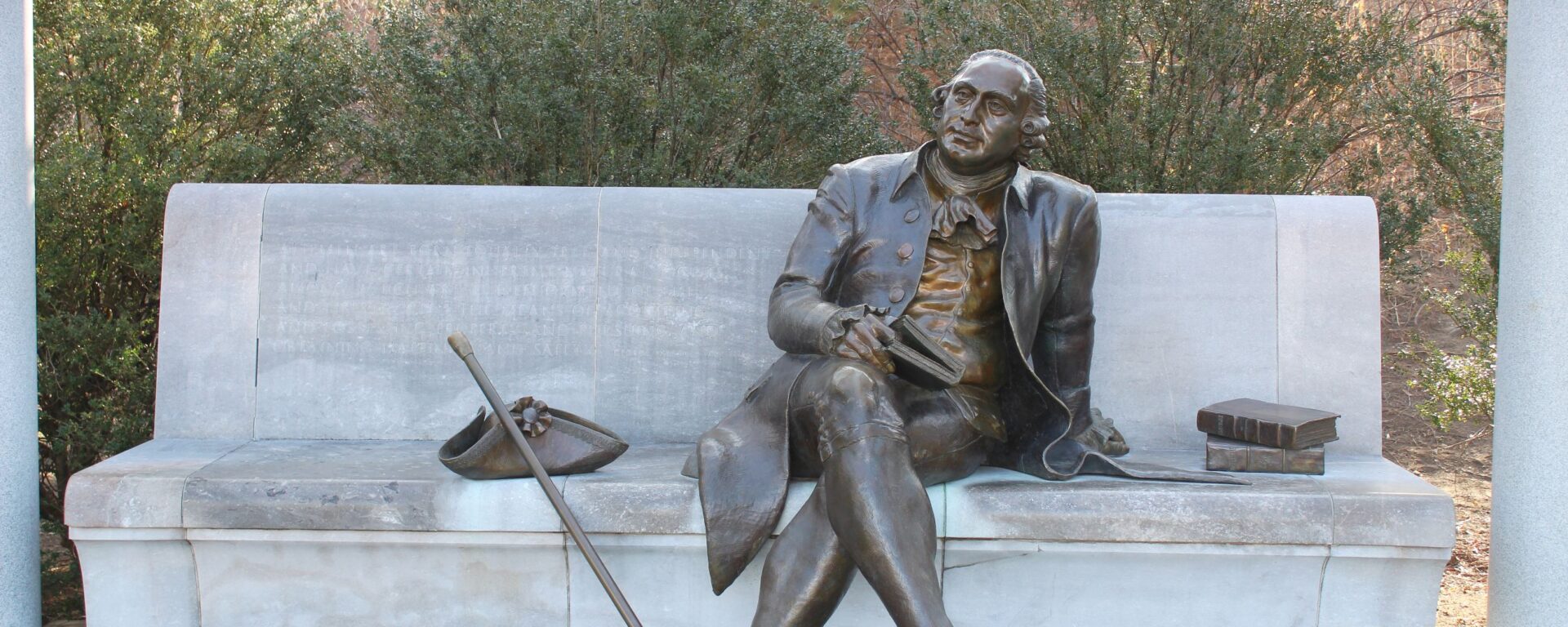“We came equals into this world, and equals shall we go out of it.”
Southwest of the Thomas Jefferson Memorial, at the northern edge of East Potomac Park, lies one of the most underseen memorials in Washington, honoring one of the least known founders of our country. Thousands pass by it daily on Interstate 395, but few stop to regard George Mason or contemplate his contributions to the country.

The George Mason Memorial is a circular park with a fountain in the center. At the southeastern edge, a pergola covers a stone bench upon which the statue of Mason is seated. Flanking the bench are two low, stone walls with quotes from Mason inscribed upon them. The statue of Mason is seated, its legs crossed, holding De Officiis by Cicero, which discusses the natural and political rights of man. To the statue’s right is a tricorn hat and a walking stick. To its left are John Locke’s On Understanding and Jean-Jacques Rousseau’s Du Contrat Social (The Social Contract), two works that inspired the founding fathers.

The memorial was dedicated in April 2002 with a crowd of over 500 in attendance. Chief Justice William Rehnquist gave the formal dedication. It was sculpted by local artist Wendy Ross and was the first monument on the Tidal Basin dedicated to a non-president.
Mason began making his reputation as a political thinker after the end of the French and Indian War. King George III was levying taxes on the American colonies to help pay off his war debts and Mason was among the prominent Americans who spoke up against the taxes. Notably, he spoke against the Stamp Acts which imposed a tax on most paper products. As the British imposed more punitive taxes on the colonies, Mason continued to work with other patriots such as George Washington, Thomas Jefferson, and Patrick Henry in the lead up to war with Britain.

In the early summer of 1776 Mason crafted his greatest political legacy. The government of Great Britain ruled Virginia in name only, and the political class wanted to frame a constitution for the state independent of the monarchy. Mason was elected to attend the Virginia convention that would draft it along with Patrick Henry and James Madison. Mason worked mostly alone to draft the 1776 Constitution of Virginia and the Virginia Declaration of Rights. The Declaration of Rights would go on to influence the language and content of the Declaration of Independence and the Bill of Rights.
Due to the death of his wife a few years earlier, and the need to care for their nine children, Mason did not participate in the American Revolution on a national scale. Mason served in the Virginia House of Delegates during the war but was frequently absent due to health issues. He reentered the national stage at the 1787 Constitutional Convention. He wrote to his son “the revolt from Great Britain and the formations of our new government at that time, were nothing compared with the great business now before us.” He was a frequent speaker at the convention and helped to negotiate the Great Compromise, but ultimately, he refused to sign the new Constitution, primarily because it did not include a Bill of Rights. Although the Constitution was eventually ratified, Mason had burned a lot of bridges in his opposition to it, and remained out of political office for the rest of his life.
Though his Declaration of Rights and Virginia Constitution would influence governments around the world for years to come, few remember his contributions to freedom here in the United States. Today he is little remembered outside of Virginia. His name lives on in George Mason University and his home still stands, both in Fairfax County, Virginia.

Resources used for this article:
https://en.wikipedia.org/wiki/George_Mason
https://en.wikipedia.org/wiki/George_Mason_Memorial
https://www.nps.gov/nama/planyourvisit/George-Mason-Memorial.htm

